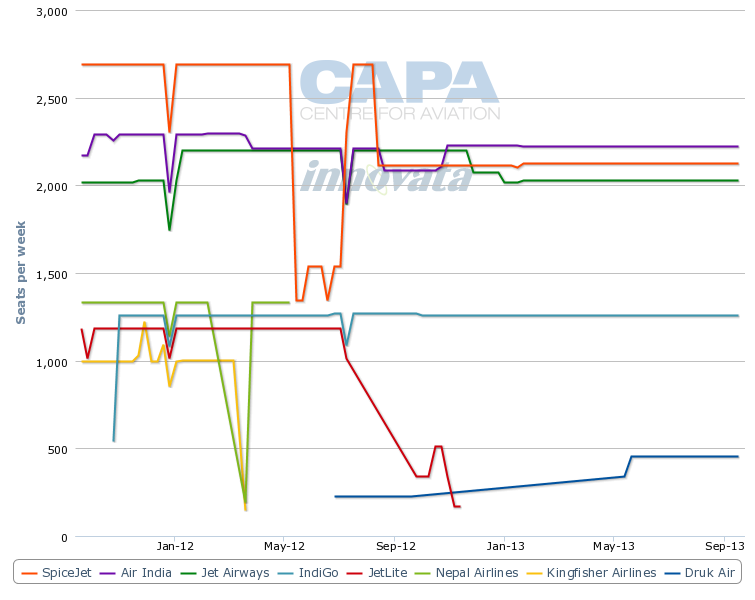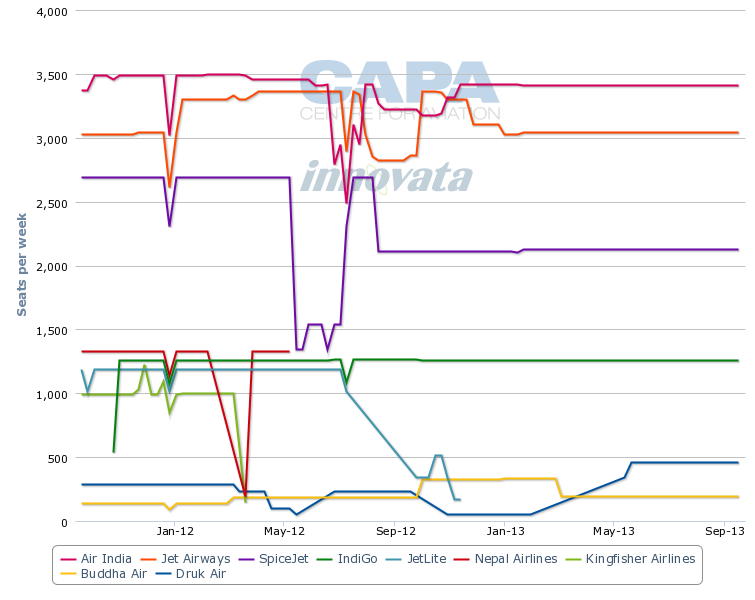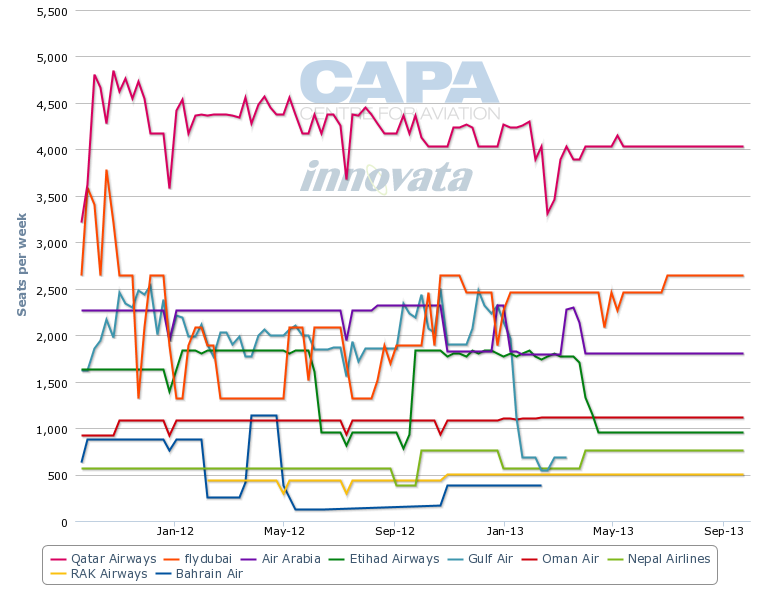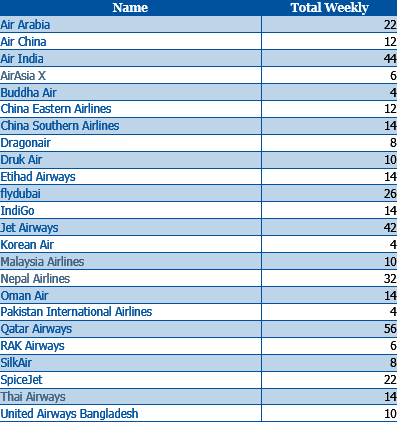Nepalese international market could see growth as BB expands and Nepal Airlines renews fleet
Nepalese start-up BB Airways aims to pursue significant expansion of its international network following a restructuring which will see the carrier replace a wet-leased Boeing 757 with two dry-leased Airbus A320s. The carrier, which launched services in Sep-2012, has had a relatively slow initial seven months but has an ambitious plan to exploit the expected rapid growth of the Nepalese international market with a focus on migrant worker traffic.
Nepal is a small but underserved market with huge potential. Foreign carriers dominate the market, exploiting the weakness of flag carrier Nepal Airlines, which recently committed to renewing its small fleet in 2015 but is unlikely to grow significantly. If it succeeds at rapidly expanding and overcoming initial challenges, BB could soon become Nepal's largest carrier.
BB is planning to add Bangkok, Doha, Delhi, Hong Kong, Lhasa, Singapore and Tokyo Narita to its network as it transitions in 2H2013 to an A320 fleet in 180-seat single class configuration. BB only currently serves Kuala Lumpur and Taipei while Nepal Airlines serves just four international destinations - Kuala Lumpur, Bangkok, Doha and Hong Kong.
See related article: Launch of BB Airways as Nepal's second international carrier shakes up Kathmandu market
Nepal is small but has big potential
Nepal is one of the smallest international markets in Asia with about 70,000 weekly seats, making it approximately the 25th biggest market in Asia-Pacific, according to Innovata data. Nepalese carriers account for less than 13% of international capacity in its home market.
Nepal Airlines, which is one of the smallest flag carriers in Asia with just 16 weekly return flights, currently accounts for 8.6% of seat capacity in Nepal's international market. BB's six weekly return flights gives the start-up a 3.5% share of capacity while Buddha Air, which is predominately a domestic carrier, accounts for less than 1%.
But Nepal has big potential as a tourism destination and for local Nepalese travel given the large number of Nepalese working abroad. Nepal has a population of about 30 million, which makes it the 18th most populous country in Asia.
There are over six million Nepalese working abroad, including about five million in other South Asian countries. It is the one million living in countries that do not border Nepal, particularly the Middle East and Southeast Asia, which provide a large migrant worker market for airlines serving the country. This is the target market for BB Airways and Nepal Airlines while the foreign carriers serving Nepal generally have a more diverse mix of passengers including migrant workers, tourists and - to a much lesser extent - business travellers.
Nepal had 598,000 visitor arrivals in 2012, an increase of 10% compared to 2011, according to data from Nepal's ministry of tourism. After roughly flat growth in the first half of the last decade, visitor arrivals have more than doubled since 2006, when there were 286,000 visitor arrivals.
Tourism is an important and growing component of the Nepalese economy, accounting for almost 3% of the country's GDP. Tourism is also the second biggest generator of foreign income following remittances from Nepalese workers living abroad.
India remains Nepal's largest market and is in the BB business plan
India is by far the largest source of tourist arrivals, accounting for 165,000 or 28% of the total market in 2012. India also accounts for approximately four million or two-thirds of the overseas Nepalese population. While much of the Nepal-India traffic crosses the border by land, India is by far the largest destination for passengers from Kathmandu, Nepal's only international airport.
There are four Indian carriers serving Kathmandu, accounting for about 28% of total international capacity in the Nepalese market. Air India and Jet Airways are the second and third largest international carriers serving Nepal, bigger even than Nepal Airlines but smaller than market leader Qatar Airways.
SpiceJet is the seventh largest carrier in Nepal's international market and the second largest LCC after flydubai. Another Indian LCC, IndiGo, is the ninth largest carrier in the market. IndiGo has only served Kathmandu since Oct-2011, when it made the Nepalese capital one of its first international destinations after turning five years old. (In India, airlines cannot operate international flights under they have served the domestic market for five years.)
Top 10 international carriers in Nepal based on capacity and capacity share: 8-Apr-2013 to 14-Apr-2013
|
Rank |
Carrier |
Weekly seats |
Share of total seats |
| 1. | Qatar Airways | 8,064 | 11.4% |
| 2. | Air India | 6,822 | 9.7% |
| 3. | Jet Airways | 6,090 | 8.6% |
| 4. | Nepal Airlines | 6,080 | 8.6% |
| 5. | flydubai | 4,914 | 7.0% |
| 6. | Thai Airways | 4,452 | 6.3% |
| 7. | SpiceJet | 4,246 | 6.0% |
| 8. | Air Arabia | 3,608 | 5.1% |
| 9. | IndiGo | 2,520 | 3.6% |
| 10. | BB Airways | 2,472 | 3.5% |
Nepal Airlines currently does not serve the Indian market, having dropped its Kathmandu-Delhi service in Apr-2012, according to Innovata data. Nepal Airlines' withdrawal and the suspension of services at Kingfisher, which also served the Kathmandu-Delhi route until early 2012, has left a void in the market which BB Airways aims to fill.
BB chief operating officer Hari Shrestha told the CAPA Aviation Finance Asia Summit in Singapore on 21-Mar-2013 that the carrier has secured traffic rights for the Kathmandu-Delhi route and plans to utilise them because services between the two cities are in high demand and surpass current capacity levels. Delhi is by far the largest destination from Kathmandu, with over 15,000 weekly seats. But capacity is down by about 30% compared to the beginning of 2012.
Kathmandu to Delhi capacity by carrier (one-way seats per week): 19-Sep-2011 to 22-Sep-2013
Air India is currently the largest carrier in the Kathmandu-Delhi market with two daily A320/A321 flights and a 29% share of seat capacity. SpiceJet and Jet Airways are only fractionally smaller, accounting for 28% and 27% shares, respectively. SpiceJet has 11 weekly flights on the route using 737-800s in single-class configuration while Jet has a double daily service with 737-800s in dual-class configuration.
IndiGo, which serves the route with one daily flight with 180-seat A320s, accounts for the remaining 16% share. Bhutan's Druk Air, which has pick-up rights between Nepal and India, also typically serves the route on a seasonal basis. Druk Air will resume four weekly flights on the Delhi-Kathmandu-Paro route in May-2013.
Total seat capacity between Nepal and India is currently about 20,000 weekly seats. Jet is the only carrier serving the Kathmandu-Mumbai route, operating one daily 737-800 flight, while Air India is the only carrier serving Kathmandu-Kolkata, operating four weekly flights with A319s.
Varanasi, a Buddhist pilgrimage site in northern India, is served from Kathmandu with four weekly Air India A321 flights and four weekly flights from Buddha Air with ATR 42 turboprops. Varanasi is the only international destination for Buddha Air, which is one of several domestic carriers in Nepal operating all-turboprop fleets.
Nepal to India capacity by carrier (one-way seats per week): 19-Sep-2011 to 22-Sep-2013
BB eyes Lhasa, a 'goldmine' in Tibet
BB has no intentions of serving other markets in India besides Delhi. It is primarily targeting medium-haul markets in East Asia and the Middle East. BB's only other planned short-haul route is Lhasa, the administrative capital of the Tibet region of China.
Kathmandu-Lhasa is a lucrative route that is currently only served by Air China with three weekly A319 flights. BB aims to capitalise on Nepalese carriers' ability to access the Lhasa market, which is otherwise not open to foreign carriers.
Lhasa is a popular tourist destination that is often combined with Nepal given the cultural links between Nepal and neighbouring Tibet. Kathmandu is currently the only international destination from Lhasa, according to Innovata data. "Lhasa is a goldmine," Mr Shrestha stated.
Otherwise the carrier is targeting markets with large Nepalese populations. Almost all of BB's passengers on its Kathmandu-Kuala Lumpur route are migrant workers.
Kuala Lumpur route is highly competitive but has sufficient demand for Nepalese airlines
Kuala Lumpur is the third largest destination from Kathmandu with over 8,000 weekly seats provided by four carriers. Migrant workers are the main source of passengers in this market as Nepal only recorded about 10,000 visitor arrivals from Malaysia in 2012. But Malaysia is the third largest country outside South Asia for non-resident Nepalese living abroad, according to data from the Non-Resident Nepali Association.
Kuala Lumpur is the largest destination for Nepal Airlines and the only route that it currently serves daily. Over the last year the market also has attracted both of Malaysia's two main airline groups. AirAsia X launched service to Kathmandu in Jul-2012 and currently serves the Kuala Lumpur-Kathmandu route with three weekly A330 flights. AirAsia X became only the third widebody operator serving Nepal, joining Thai Airways and Dragonair.
Malaysia Airlines (MAS) followed AirAsia X by launching Kathmandu in Sep-2012 and currently serves the route with five weekly 737-800 flights. MAS and BB each currently account for 20% of seat capacity in the Kathmandu-Kuala Lumpur market while Nepal Airlines has a leading 32% share and AirAsia X accounts for a 28% share, according to CAPA and Innovata data.
AirAsia X and MAS both compete against Nepal Airlines and BB Airways for migrant worker passengers. But they also carry a large number of tourists, primarily tourists originating in other countries in Asia as well as Australia and connecting in Kuala Lumpur, while Nepal Airlines and BB are focused almost entirely on Nepalese passengers. BB does not yet have an Internet booking engine (it plans to start selling tickets online later this year) and relies on travel agents.
BB Airways chairman Bhaban Bhatta told CAPA that the carrier has been able to achieve high load factors to Kuala Lumpur despite the competition. But as it is a migrant worker market there is an imbalance, with BB's average load factor near 100% to Kuala Lumpur but only about 55% on the return to Kathmandu. AirAsia X and MAS have an advantage by carrying a wider mix of passengers, giving the Malaysian carriers a better balance.
Mr Bhatta said that BB has also recorded an average load factor of 85% to Taipei, a route no other carrier currently serves with direct flights. But the service is less than ideal as it is operated with a stop in Siem Reap in Cambodia. A non-stop flight became unfeasible after the Chinese Government denied an over-flight permit because the flight was not being operated with a Nepalese registered aircraft. BB expects it will be able to secure an over-flight permit from Chinese authorities for the Taipei route once it starts operating its own aircraft.
BB needs to substitute wet-leased aircraft to become viable
BB has been wet-leasing a 757 from Cambodian charter carrier TonleSap Airlines. BB has been using one 757 with a second 757 allocated by TonleSap to BB as a back-up. The aircraft has 206 seats with a convertible cabin at the front, giving BB the flexibility to sell a business class product or only offer economy.
Wet-leasing aircraft can be an expensive proposition and the 757 has proven to be not the ideal type for BB's routes. As a result the carrier is seeking to transition to its own aircraft. Its preference is the A320, which it plans to operate in single-class 180-seat configuration. "We are in the process of restructuring operation and switching to suitable aircraft," Mr Shrestha stated at the CAPA conference.
BB aims to begin A320 operations in the Sep/Oct-2013 timeframe with an initial fleet of two aircraft. The carrier already has an operators' certificate from Nepalese authorities although has not yet operated its own aircraft.
Middle East-Nepal market is large but budget focused
There is limited demand for a business class product in Nepal given that most passengers are budget conscious migrant workers and tourists. Even Qatar Airways has at times used an all-economy A320 on the Doha-Kathmandu route. Qatar Airways CEO Al Baker likes to refer to the one all-economy A320 in the Qatar fleet as an example of how the carrier can quickly launch a budget airline subsidiary if market conditions dictate. But the reality is there is limited demand for business class in the Kathmandu market, making it an ideal market for an all-economy configuration.
Qatar currently operates four daily A320 frequencies to Kathmandu, making it the largest carrier in the Nepalese international market. Doha, which is also served by Nepal Airlines with four weekly flights, is the second largest destination from Kathmandu after Delhi. Not surprisingly it is also a planned route for BB, which sees enough demand from the migrant worker segment to support a third carrier.
Qatar along with Saudi Arabia and the UAE are home to the largest populations of Nepalese workers outside South Asia. While Saudi Arabia does not have non-stop services to Nepal, this market is spread out across multiple cities in Saudi Arabia and is typically served via Doha, Dubai and Abu Dhabi.
Kathmandu has become a big market for Emirates' sister carrier flydubai, which serves the Dubai-Kathmandu route with two daily flights. Emirates, which only operates widebody aircraft in two and three class configuration, does not serve the market but has access to Kathmandu through its codeshare with flydubai. Etihad also operates a daily A320 flight from Abu Dhabi to Kathmandu while independent budget carrier Air Arabia operates 11 weekly flights from its base at Sharjah, the third largest airport in the UAE, using A320s.
A fourth UAE carrier, RAK Airways, serves Kathmandu with three weekly A320 flights from Ras Al Khaimah. Oman Air also serves Kathmandu from its Muscat base with a daily A320 flight.
Kathmandu was also linked with Bahrain until Mar-2013, when Gulf Air dropped Kathmandu from its network as part of its restructuring. Bahrain Air also served Kathmandu before ceasing operations in Feb-2013. There could be an opportunity for a Nepalese carrier to enter the Bahrain market as passengers travelling between the two countries, including the Nepalese population working in Bahrain, must now travel via other Middle Eastern hubs.
In total there are currently about 24,000 weekly seats in the Nepal-Middle East market, which is more than double the capacity between Nepal and East Asia. The strong presence in the Nepalese market by Middle Eastern carriers could make it challenging for BB to build up a meaningful operation in the region.
Nepal to Middle East capacity by carrier (one-way seats per week): 19-Sep-2011 to 22-Sep-2013
The Middle Eastern carriers have the advantage of being able to carry migrant Nepalese workers as well as offer connections beyond their hubs, particularly to Europe, which accounts for 27% of Nepalese visitor arrivals.
BB will likely find it easier to focus on routes to the east, which are generally less competitive and are growing more rapidly. Visitor arrivals from East Asia were up by 15% in 2012 to 127,000 while arrivals from Europe were up less than 5% to 161,000. Economic growth in East Asia is also leading to more Nepalese workers being posted to East Asian markets such as Malaysia.
Bangkok and Hong Kong are among several planned new Far East destinations for BB
Bangkok is the fifth largest international destination from Kathmandu, following Delhi, Doha, Kuala Lumpur and Dubai. Thailand is a big market for Nepalese travellers and Bangkok-Kathmandu flights, particularly the daily 777 service from Thai Airways, also carry a large number of tourists that predominately transit in Bangkok to flights throughout Asia and beyond. Nepal Airlines currently only serves Bangkok with two weekly flights, leaving a void that BB aims to fill as it looks to also serve the Kathmandu-Bangkok market.
BB also aims to launch service in 2013 to Hong Kong and is negotiating with authorities for permissions that would allow it enable the flight to continue onto Japan on a Kathmandu-Hong Kong-Tokyo Narita route. BB originally planned to add Kathmandu-Hong Kong in late 2012 but ended up suspending the route before the initial launch date.
Singapore is also on BB's future network map. Kathmandu-Singapore is now served by Singapore Airlines regional subsidiary SilkAir with four weekly flights while Kathmandu-Hong Kong is served by Dragonair daily and by Nepal Airlines with three weekly flights. Hong Kong has a large Nepalese population and Singapore also has a large number of Nepalese migrant workers.
Nepal Airlines finally commits to A320s
BB sees an "immense opportunity" in the Nepalese market, where it could quickly become the leading carrier given the weak position of Nepal Airlines. Government-owned Nepal Airlines, formerly known as Royal Nepal Airlines (RNA), has struggled financially over the last several years and shrunk in size due partially to a lack of government funding. Nepal Airlines currently operates international flights with a fleet of two 757s, one of which is frequently grounded, leading to delays and flight cancellations.
But Nepal Airlines appears to be close to finalising plans to bring in A320s, ending a period of over three years in which plans to renew its fleet with new Airbus aircraft were repeatedly stalled. The carrier on 5-Apr-2013 reportedly signed a revised memorandum of understanding with Airbus covering the purchase of two A320s, which will be delivered in 2015.
The deal follows an initial MOU that was signed with Airbus in late 2009 covering one A320 and one A330. Nepal Airlines later decided to adjust its fleet plan and focus on the A320s, which will be used on routes within Asia and the Middle East, and push back plans to take on widebody aircraft. The original MOU with Airbus was never converted into a firm order and there was no progress with securing the required government approvals to bring in the aircraft until late 2012, when the government signed contracts for new Chinese-build turboprops for domestic services and indicated it would back the long-delayed order with Airbus.
Nepal Airlines' recent progress with finally renewing its fleet will give the flag carrier an improved and more reliable product, allowing it to compete more effectively against BB Airways and foreign carriers. But it will be at least two years before Nepal Airlines receives its new aircraft, giving BB or other Nepalese start-ups an opportunity to grow and capture a bigger segment of the market than Nepal Airlines.
The two A320s will also not provide significant growth opportunities for Nepal Airlines as the carrier will need to phase out its current fleet of two ageing 757s. To keep up with growth in the Nepalese market the flag carrier will need additional A320s, which it could struggle to secure given the repeated delays in lining up the approvals for the initial two aircraft.
BB Airways has an opening but also faces challenges
Nepal Airlines' decision to not acquire A330s also leaves an opening for another Nepalese carrier to launch long-haul services. BB has widebody aircraft and long-haul routes to Europe and Australia in its medium to long-term business plan but for now is focused on expanding regionally with A320s.
BB has its own challenges, including securing aircraft and sufficient capital to fund its planned expansion. The Nepalese international market has a lot of potential but it is significantly easier for larger and well-funded foreign carriers to expand.
There is a niche for a local carrier or two that is modest in size and focused on Nepalese passengers residing locally and overseas. But if overly ambitious and too eager to take on foreign carriers on routes that do not have very strong migrant worker demand, the challenges quickly become insurmountable.
Background information
Nepal schedule summary of international market: as of 8-Apr-2013



